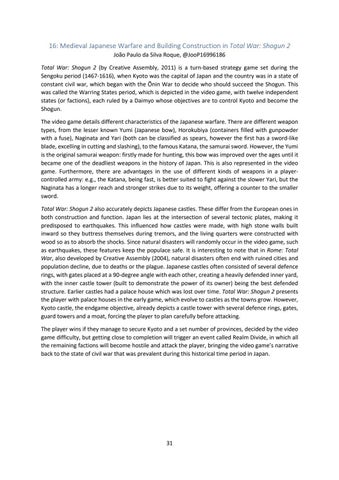16: Medieval Japanese Warfare and Building Construction in Total War: Shogun 2 João Paulo da Silva Roque, @JooP16996186 Total War: Shogun 2 (by Creative Assembly, 2011) is a turn-based strategy game set during the Sengoku period (1467-1616), when Kyoto was the capital of Japan and the country was in a state of constant civil war, which began with the Õnin War to decide who should succeed the Shogun. This was called the Warring States period, which is depicted in the video game, with twelve independent states (or factions), each ruled by a Daimyo whose objectives are to control Kyoto and become the Shogun. The video game details different characteristics of the Japanese warfare. There are different weapon types, from the lesser known Yumi (Japanese bow), Horokubiya (containers filled with gunpowder with a fuse), Naginata and Yari (both can be classified as spears, however the first has a sword-like blade, excelling in cutting and slashing), to the famous Katana, the samurai sword. However, the Yumi is the original samurai weapon: firstly made for hunting, this bow was improved over the ages until it became one of the deadliest weapons in the history of Japan. This is also represented in the video game. Furthermore, there are advantages in the use of different kinds of weapons in a playercontrolled army: e.g., the Katana, being fast, is better suited to fight against the slower Yari, but the Naginata has a longer reach and stronger strikes due to its weight, offering a counter to the smaller sword. Total War: Shogun 2 also accurately depicts Japanese castles. These differ from the European ones in both construction and function. Japan lies at the intersection of several tectonic plates, making it predisposed to earthquakes. This influenced how castles were made, with high stone walls built inward so they buttress themselves during tremors, and the living quarters were constructed with wood so as to absorb the shocks. Since natural disasters will randomly occur in the video game, such as earthquakes, these features keep the populace safe. It is interesting to note that in Rome: Total War, also developed by Creative Assembly (2004), natural disasters often end with ruined cities and population decline, due to deaths or the plague. Japanese castles often consisted of several defence rings, with gates placed at a 90-degree angle with each other, creating a heavily defended inner yard, with the inner castle tower (built to demonstrate the power of its owner) being the best defended structure. Earlier castles had a palace house which was lost over time. Total War: Shogun 2 presents the player with palace houses in the early game, which evolve to castles as the towns grow. However, Kyoto castle, the endgame objective, already depicts a castle tower with several defence rings, gates, guard towers and a moat, forcing the player to plan carefully before attacking. The player wins if they manage to secure Kyoto and a set number of provinces, decided by the video game difficulty, but getting close to completion will trigger an event called Realm Divide, in which all the remaining factions will become hostile and attack the player, bringing the video game’s narrative back to the state of civil war that was prevalent during this historical time period in Japan.
31









